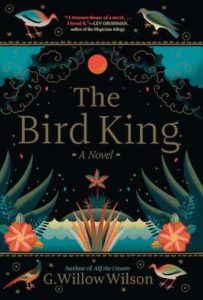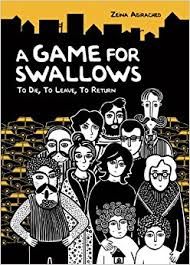It reminds me of Peter Turchi’s quote: “The first lie of a map—also the first lie of fiction—is that it is the truth.” Still, that’s part of the seductive quality of maps for me. And when authors take advantage of that beguiling trait, I’m hooked. Some authors have done a masterful job of that, incorporating unique maps into the folds of their stories in ways that confuse, challenge, captivate, surprise, or completely trick the reader. Think the Marauder’s Map, which reveals itself but also hides so much (and can hide itself entirely with the right words). Here are a handful of alluring novels that take readers beyond the perimeter of the typical map, featuring them as much more than mere reference material.
The Bird King by G. Willow Wilson
Imagine having the ability to draw up maps of places you’ve never seen, and bend those spaces to your creative will. To create entries into any place on earth, no matter how mythic…This magical art is the crux of the plot for this novel, which was pure enchantment for me. Set in the late 1400s during the last sultanate of Iberia, The Bird King tells the story of Fatima, a palace concubine, and Hassan, coveted mapmaker and Fatima’s closest friend, as they make their escape from a sultanate about to fall to Spanish monarchy. Hassan’s otherworldly cartographic skills literally create lands that would otherwise be off the map, and I couldn’t wish for a more tantalizing gift.
The Selected Works of T.S. Spivet by Reif Larsen
When one thinks of the map, they most likely envision a flat image, full of contours, boundaries, geographical locations, and the like. This book defies that conception entirely, rendering the entire novel a map of the child protagonist’s mind and heart. Filled with marginalia, story asides, graphs, and models, each page of the book is a psychological map of T.S. Spivet, a young boy who uses different kinds of mapping approaches (from artfully capturing the methods of shucking corn to graphing the levels of loneliness in others). Ultimately, we understand that his scientific analysis of the world around him, starting with the intricacies of his home life, is his coping mechanism for suffering a family-shattering trauma. I’m always in awe of how much I feel whenever I pick this book up. The little anecdotes and studies that are scattered throughout act as a figurative and tangible roadmap—each one gives you a glimpse into his soul, and you can’t help but follow the trajectory of one diagram to another.
A Game for Swallows by Zeina Abirached
At first glance, the map that kicks off this graphic novel seems straightforward enough. A geopolitical map of Lebanon during the time of its civil war from 1975 to 1990. Appropriate and useful to envelope the reader into the author’s memory of one terrifying night as a young girl when she and her siblings were separated from her parents by a mere few blocks. But the following 40 or so pages are filled with varying kinds of maps, the most poignant being a side-by-side comparison of two views of the same area: one showing the street route between the girl’s home and her grandparents, the second showing how they actually travel between the two places by jumping walls, hiding from snipers, waiting, and running when safe. It’s an illuminating vision of the effects of war on a child resident’s perspective, particularly hard-hitting because the whole book is in black and white.
The Talented Ribkins by Ladee Hubbard
Part American road trip, part politics and race relation exploration, and part, well, something just over the edge of fantastical, it has something to appeal to all sorts of readers. And the maps, well, when your main character can literally draw up the finest details of any location, without ever even having been there, that’s pretty exhilarating. It also lends itself to dangerous and unforgiving situations. The whole Ribkin clan is brimming with supernatural powers, creating a not-so-common situation for the African American family. The act and metaphor of mapmaking go hand-in-hand in drawing a family together, no matter that obstacles.

